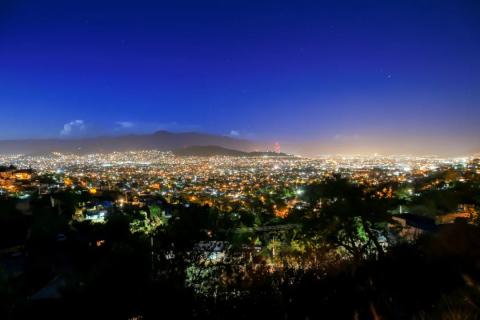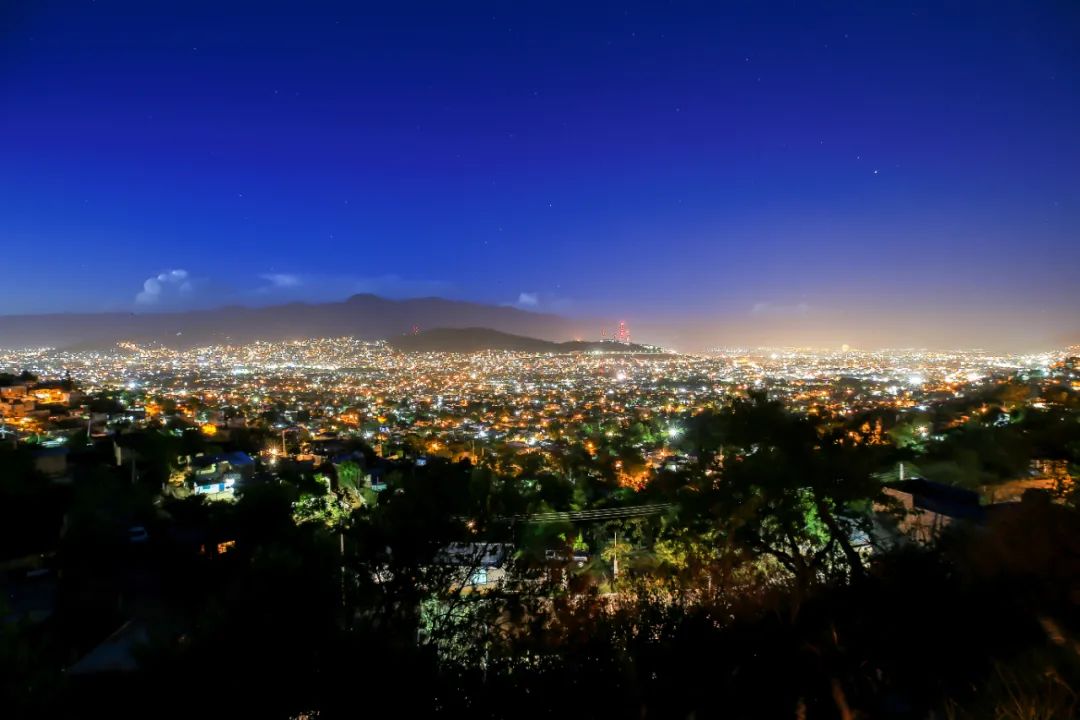
The 4,500-kilometer self-driving journey is now halfway through. Leaving the land of the Mayan dynasty, we dived into the hundreds of thousands of mountains in central Mexico; the wheels spiraled up and down with the mountains. The Mexico in front of us quickly took off its gorgeous coat of tourist areas, revealing its original charming appearance. Here is Mexico's largest ethnic minority group: The mountain roads are rugged and narrow. In an era when transportation was underdeveloped, the mountains became barriers to protect various ethnic groups; they are culturally tolerant and have a hundred flowers blooming wonderfully. Self-driving makes destinations that are difficult for tourists to reach possible, and it also makes me understand that there is much more to Mexico than the scenery and vacation on the beaches of Cancun.

san cristobal
The full name of San Cristóbal de las Casas is San Cristóbal de las Casas, and the name does sound rather difficult to pronounce. The small town is located on a plateau at an altitude of 2,200 meters. As soon as you get off the car, you can feel the biting chill. Before coming here, I saw a travel note mentioning that this place is like a Mexican version of Dali. After walking around the city, it turned out to be very similar. In addition to the high altitude, bright sunshine and blue sky, the Mexican artistic youths all over the city, all holding guitars and wearing dreadlocks, are also a sight to behold. The same songs are played in roadside cafes and hotel restaurants. When you open the door of the bohemian-style restaurant, you can feel the young and lively atmosphere. I never expected to discover another side of the country in the mountains of Mexico, far away from the hustle and bustle.

San Cristóbal is small in size, and the yellow main church is particularly conspicuous in the center of the small town. Surrounding the central square, there are four churches of different shapes in the east, west, north and south of the town. In addition, the handicraft market and the Boutique El Camino de los Altos shopping mall on the south side of the square are both worth a stay.

Located on the top of the hill to the west of the town is the red church (Church of San Cristobalito). You can walk to the top of the mountain along a few steps. But I didn’t expect that the altitude of 2200 meters would make me out of breath , I didn’t feel like this in Lhasa before.


Directly opposite the red church is the yellow church (Guadalupe Church) on the east side of the town. This church is located on a higher ground and is a good place to watch the sunset.


Walking is the only way to unlock San Cristobal . In addition to the cathedrals scattered in the streets and alleys, the Beetle cars filling the streets of the town and the exquisite shopping malls that may be a little out of tune with the surrounding environment—— Boutique El Camino de los Altos are a great way to spend some time.



Calle Real de Guadalupe is the main pedestrian street of San Cristobal. Hotels, B&Bs, restaurants and bars are lined up along the way; when night falls, the tables outside are crowded with people of all kinds. All kinds of Mexican young people are singing and dancing, and the pedestrian street is already a sea of joy.
Burittos has always been regarded as the signature Mexican cuisine in North America, which is a corn burrito filled with different meats and vegetables. After arriving in Mexico, it was difficult to find traces of Burittos. The restaurant TierrAdentro on the pedestrian street allowed Chen to eat authentic Mexican Burittos for the first time. The taste was amazing. This restaurant is recommended by Lonely Planet. There is outdoor seating, and the interior of the restaurant looks more like a beer bar.
Yik Cafe, located not far from the main square, is a "normal" American breakfast restaurant that is rare to find in Mexico. Although it is not as "curative" as an Asian restaurant, the Waffle in the store still saves the Oriental stomach. , during the two days in San Cristobal, Yik Cafe was the place I visited the most in this small city.

In addition to the city itself, travel agencies in San Cristóbal also offer day trips to two nearby Mayan villages Zinacantan & Chamula and to Cañón del Sumidero (Sumidero Canyon , very similar to the Three Gorges, you need to take a boat, 250-300 Peso, the journey is about 7 hours), if you are interested, you can join a group tour.
Oaxaca
Oaxaca is the capital of the state of Oaxaca. This state is a region with a large number of indigenous ethnic groups. 50% of the population is local ethnic minorities. It is similar to my country's Yunnan and Guizhou provinces, and Oaxaca's terrain is diverse. As a mountainous area, the mountains have become a barrier to protect various ethnic groups, so that although their cultures have the same roots, they have developed different characteristics due to limited exchanges. Oaxaca seems to be a corner that is often overlooked by tourists. This city, together with Monte Albán (Albán Mountain, the remains of the city-state located on the west side of the city), was named a World Cultural Heritage in 1987.

The most famous one in Oaxaca is undoubtedly: Guelaguetza (Oaxaca Guelaguet Carnival). As mentioned earlier, Oaxaca has many ethnic minorities, and these ethnic minorities still maintain their own traditions. and culture, most of them still live in villages in the mountains of Oaxaca; however, during the annual Oaxaca Guerraguete Carnival, all tribes will gather in the old town of Oaxaca to celebrate Together, people from different villages put on traditional costumes representing their respective ethnic groups and sang and danced on the street, which was very lively. Carnival begins on the last Wednesday at the end of July every year. Various activities are held every day, the most important of which are the National Costume Parade (Desfile de Delegaciones) on Saturday and the Peak Theater Performance on Monday ( Guelaguetza Lunes del Cerro).

Santo Domingo Cathedral (Templo de Santo Domingo) is located north of Oaxaca's old town. Construction of the church began in 1575 and took 200 years to complete. During the Revolutionary War, the church was turned over for military use and served as a military barracks from 1866 to 1902. The church resumed religious use in 1938 and underwent a comprehensive restoration in 1993. The church you see now is gleaming and decorated with more than 60,000 23.5-carat gold leaves.


Next to the Cathedral of Santo Domingo is Santo Domingo Cultural Center Museum Centro Cultural Santo Domingo ), its predecessor The museum houses an important collection of pre-Columbian artifacts. The former monastery gardens are now the famous Oaxaca Botanical Gardens.


The Botanical Garden of Oaxaca (Jardín Etnobotánico de Oaxaca) is quite famous online. Because individual visitors are not accepted, you have to join a guided tour at a fixed time every day to go to the Botanical Garden. The ticket price is about 100 Peso. The Spanish tour is available from Monday to Saturday at 10:00, 12:00, and 17:00, three times a day. Of course, if you don’t have so much free time, then the corridor on the second floor of the monastery is enough to overlook the botanical garden, as shown below.

Like every Latin American city, Zócalo is the center, and Oaxaca is no exception. In addition to the large and small churches of different styles around Oaxaca's Zócalo, the nearby Central Market (Mercado Benito Juárez) is a great place to find food and selections A great place for local flavours. The most famous dish in Oaxaca must be mentioned here: Mole, which is a black and sticky sauce; this is not a dark dish, but a mixture of chili peppers, spices and Mix the chocolate together to make the topping. Ugly does not mean it tastes bad. Mole can be poured on any kind of food and served with tortillas or rice. It has an indescribable and strange taste. In addition to Mole, Oaxaca also has specialty hot chocolate. There is a chain of local hot chocolate shops: Mayordomo. After a tiring trip, have a cup of Oaxaca's version of Milo, which is sweet but not greasy. Hot chocolate paired with a loaf of warm bread is a standard local breakfast.



Around Oaxaca: Hierve El Agua Falls
The Rolling Water Falls is the most famous attraction around Oaxaca. Hierve El Agua is translated as "Boiling Water" in Spanish and as Rolling Water Falls in Chinese. Like Pamukkale in Turkey, the formation here contains freshwater springs. The spring water is rich in saturated calcium carbonate and other mineral elements. When the spring water seeps out from the cliff outlet, excess minerals will be deposited. After millions of years, accumulation to form what it is now. The scenic spot consists of two waterfalls, one large and one small. The large waterfall is called Cascada Grande, which is about 80 meters high (it is the petrified waterfall often seen in photos), and the small waterfall is called Cascada Chica, which is about 42 meters high (above the small waterfall There are calcification pools).
The rolling water waterfall is not big. You have to drive on a highway all the way from Oaxaca. After getting off the highway, you need to go through a mountain road. The road is in good condition. After passing through a small town, you can reach the scenic spot. From the parking lot, you can walk directly to the calcification pool of the small waterfall. From here, you can overlook the stalactite cliffs of the large waterfall. There is also a hiking loop in the scenic area, with a drop of about 80 meters. You can detour to the bottom of the petrified waterfall. It takes 2-3 hours to walk and stop in such a circle.

The Rolling Water Falls is a well-known local tourist attraction. Every weekend, surrounding residents mobilize their families because the calcification pool above the waterfall can be used for swimming. It is naturally a paradise for children to play in the water in summer.


In the south of Oaxaca, there are Monte Albán(Monte Albán) which are also worth visiting. If you are driving by yourself, this place will often be the same as Visit the Convent of Guerrero Cuilapam(Convent of Guerrero Cuilapam) together. If you are unable to drive to the ruins of Monte Alban, in the south of Oaxaca, about 400 meters walking distance from Zocalo, there is a bus stop: Autobuses Turísticos (opposite Hotel Rivera del Ángel), where you can take a minibus to Alban. Banshan Ruins, 08:00-16:00, one bus every hour, 30 minutes journey, 60 pesos round trip, return time will be printed on the ticket.

